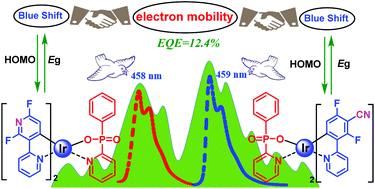Design of pyridinylphosphinate-based blue iridium phosphors for high-efficiency organic light-emitting diodes†
Abstract
At present, cyclometalated iridium (Ir)(III) complexes are the most promising emitters for OLEDs. Contrary to well-developed Ir(III)-based red and green phosphorescent complexes, the efficient blue emitters are limited and the performances of blue OLEDs are still not satisfactory. Inspired by this, we designed two novel blue Ir(III) complexes employing 2-(2,4-difluoropyridyl)pyridine (dfpypy) and 2,6-difluoro-3-(pyridin-2-yl)benzonitrile (FCN) as the main ligands, respectively, and phenyl(pyridin-2-yl)phosphinate (ppp) as the ancillary ligand. The rational design of the molecular structure makes the two complexes achieve blue emission and possess good electron mobility simultaneously. The devices based on the Ir(III) phosphors exhibited good electroluminescence performances with low turn-on voltages, a peak current efficiency of 24.51 cd A−1, a maximum external quantum efficiency of 12.4%, a peak power efficiency of 21.99 lm W−1 and low efficiency roll-off. These results provide an effective strategy for the future molecular design of blue Ir(III) complexes with good electron transport property for OLEDs.



 Please wait while we load your content...
Please wait while we load your content...